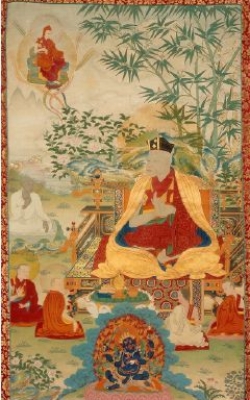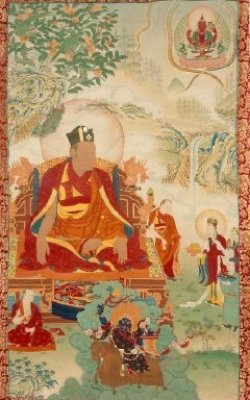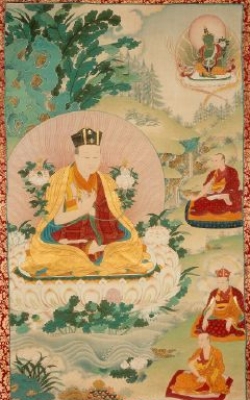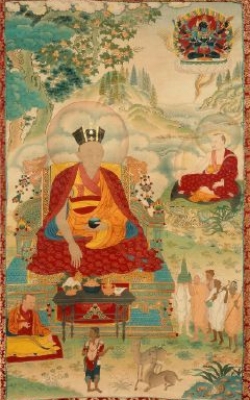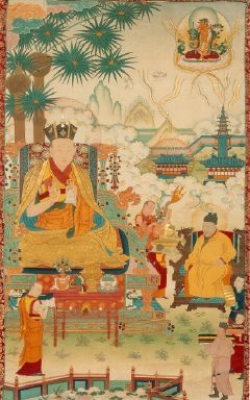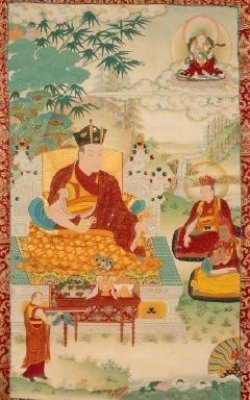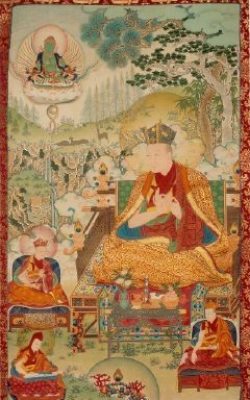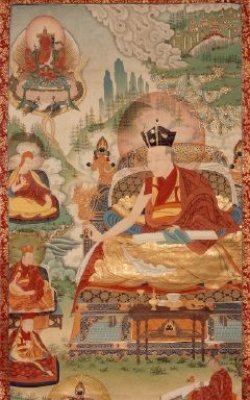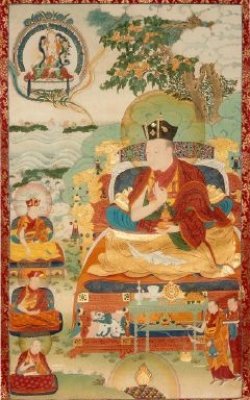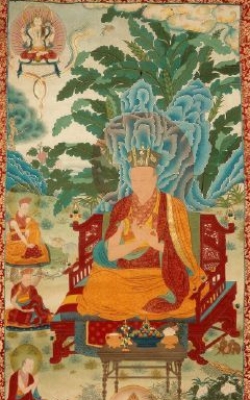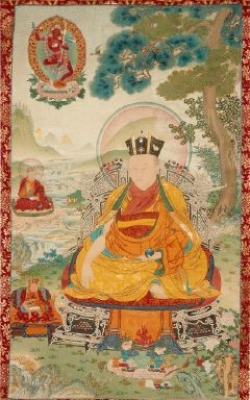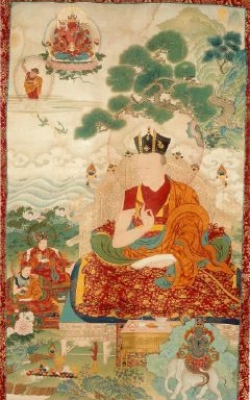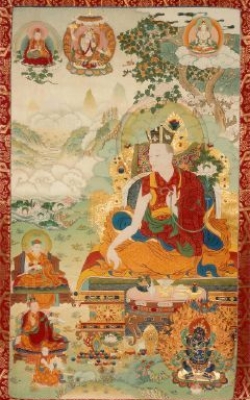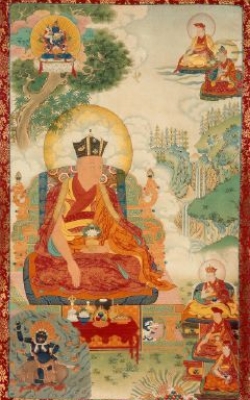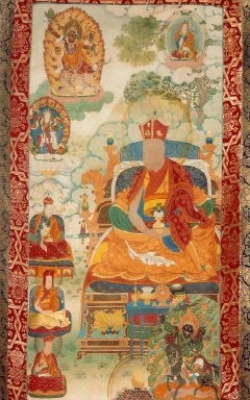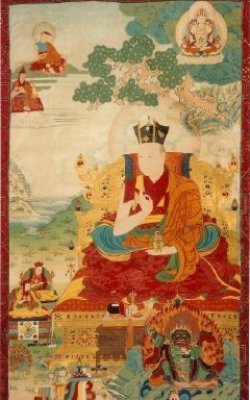Karmapa IX - Wangchuk Dorje
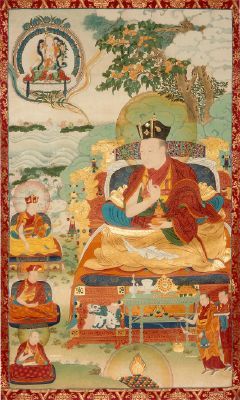
THE IXth KARMAPA
(1556 - 1603)
The ninth karmapa, Wangchuk Dorje, was born in the seventh month of 1555. It is recorded that immediately after his birth he wiped his face three times and declared, "I am Karmapa." The infant quickly became famous and reports of him reached Situ Rinpoche at Karma monastery. Since the circumstances of the birth coincided with the details contained in a prediction written down by Mikyo Dorje in his twenty-eighth year, Situ Rinpoche dispatched two assistants to investigate the infant. The assistants reported that they were satisfied that the child was indeed Karmapa. Situ Rinpoche then informed the officials of Tsurphu monastery that the new Karmapa incarnation had been discovered.
The small black hat, the seal, the robes and some ritual implements of the Karmapas were sent from Tsurphu to Karma monastery. The boy correctly identified a bell, which had belonged to Chodrag Gyatsho, the seventh Karrnapa. The following year, Shamar Konchog Yenlag conveyed the ritual objects entrusted to him by Mikyo Dorje. At about the same time, the political authorities in central Tibet sent letters of authority recognizing the new Karmapa incarnation. This last move reflected the secular power's awareness of the political importance of the Karmapa at this time. Increasingly the various schools were being brought willingly or unwillingly into the political arena. This was an important trend during the troubled life-times of the next three Karmapas.
At the age of six, Wangchuk Dorje was ceremonially enthroned by Shamar Rinpoche. He also received refuge and bodhisattva vows and the empowerment of Amitayus as well as many other textual transmissions, empowerments and teachings. Shamarpa continued to teach the young Karmapa, giving him the textual transmission of texts from the Tripitaka and certain Kagyupa texts. During this time Karmapa’s monastic camp journeyed slowly to Tsurphu. On the way Wangchuk Dorje accompanied Shamar Rinpoche in pilgrimage to Kampo Nenang, where Dusum Khyenpa had meditated.
The journey continued through Surmang and Nangchen,, arriving at Tsurphu in the new year period of 1561. In his first public teaching, Wangchuk Dorje taught the four dharmas of Gampopa to eighteen hundred monks and many political representatives of central Tibet. Then, accompanied by Shamarpa and Pawo Rinpoche, the young Karmapa undertook a pilgrimage to southern Tibet. The camp stopped at Lekshay Ling monastery, where Wangchuk Dorje honoured the enshrined remains of the first Karma Thinleypa. From there they travelled into Lhodrak, the home of Marpa, the father of the Kagyu lineage. Pawo Rinpoche assisted Shamar Rinpoche in performing the novice ordination for the young Karmapa. His two tutors also began to instruct him in the teachings of Mahamudra and the six doctrines of Naropa.
The greater part of Wangchuk Dorje's childhood was spent traveling with his camp. This nomadic monastery was very strict in its discipline and the intensity of practice. The scholars among Karmapa's entourage concentrated upon the study of the Hevajra Tantra and the Chakrasambhava Tantra, the Uttaratantra Sastra of Maitreya, and the Zabmo Nangdon of Rangjung Dorje. The advanced tantric practitioners of the monastic camp practiced the six yogas of Naropa, Mahamudra and Chöd. The camp's ordinary practitioners and monks meditated upon Vajrayogini, Avalokitesvara and Hayagriva. In order to be fully accepted into Karmapa's entourage at this time, a follower had to have accomplished a great amount of spiritual practice.
At Shamar Rinpoche's monastery of Yangbachen, Wangchuk Dorje instructed the monks in various teachings. He spent three months at the court of the local prince in Rinpung, Ngawang Jigten Wangchuk. He received a visit there from Lama Sonam Gyatsho, the then head of the Gelugpa sect. Sonam Gyatsho later received the title of Dalai Lama (“Ocean Guru") from the Mongol, Aarten Khan.
Wangchuk Dorje next journeyed through the Kongpo province in southern Tibet, which had always been a stronghold of the Kamtshang and Drukpa Kagyu. Sharnarpa instructed him in the teachings of Rangiung Dorje and Mikyo Dorje as they travelled.
In addition to his studies, Wangchuk Dorje was called upon to mediate and arbitrate local disputes. Having moved the camp south to Tsari, Karmapa received a second visit from Sonam Gyatsho, who requested him to mediate a political dispute in the Yarlung principality. Together, the two Lamas brought about a three-year treaty and then parted after an exchange of gifts.
In 1580 Wangchuk Dorje received the final ordination from Shamar Rinpoche. Subsequently, he studied the vinaya and then the teaching of the fifth, sixth and seventh Karmapas. As well as these Kamtshang Kagyu teachings, Karmapa also received textual transmissions of texts from the Drigung Kagyu and Kadampa lineages from Shamar Rinpoche.
In 1583 Shamar Rinpoche passed sway, Wangchuk Dorje enshrined his guru's remains in a Stupa at Yangbachen monastery. He undertook to divide Shamarpa's property among the monasteries at U and Tsang, giving gifts and tea to poor people and a gold mandala to the great temple at Lhasa. After a pilgrimage to sacred places in northern Tibet, Wangchuk Dorje returned to Tsurphu, where he transmitted the texts of Mikyo Dorje and the Drigung Kagyu tradition to Pawo tulku. He also ordained many monks at this time and ordered the completion of an enormous silk applique thangka of Buddha Sakyamuni.
It was then necessary for Wangchuk Dorje to travel to Rinpung, where he settled some political difficulties. Karmapa was saddened by the political troubles of his time. He felt that the memory of the early period of Buddhism in Tibet would inspire a renewed dedication to the civilizing messages of dharma. In pursuit of this aim he arranged for the repair of temples built by the earlier Buddhist kings, Srongtsen Gampo and Trisong Detsen.
After ordaining the third Pawo tulku, Tsuglak Gyatsho, Karmapa entered into retreat for a year at Tsurphu. Then he set out on a tour of northern Tibet, where it was said that the king of the Naga made an offering to him, symbolizing the dedication of the area of Karmapa. People attributed that year's good weather and harvests to this offering.
Although not as prolific an author as the previous Karmapa, Wangchuk Dorje composed some important texts, including a commentary on the Drigung "one thought" viewpoint. His most important book was “The Ocean of Certainty” (Tib.:ངེས་དོན་རྒྱ་མཚོ་), from which has come the liturgy of the preliminary practices of mahamudra. Another important work of the ninth Karmapa was entitled, “Eliminating the Darkness of Ignorance” (Tib.: མ་རིགས་དམུན་བསལ་) and this was also concerned with Mahamudra. Both are in current use today.
Wangchuk Dorje engaged extensively in work in both the religious and social spheres. At Ngakphu he ordained many monks among the local People. He also stopped hunting and fishing and tried to inculcate in the local people an attitude of reverence toward animals. In addition, Karmapa arranged for the construction of bridges in the area.
A little later, word reached Wangchuk Dorje that the new Shamar incarnation had been born in a Drigung family. He recognized the child as the incarnation and, at about this time, also ordained a large number of Drigungpa monks. In 1594 Karmapa took the infant Shamarpa hack to Tsurphu where he began to instruct him in the Kamtshang tradition.
Wangchuk Dorje next journeyed with his monastic camp to Tsari. There he taught Vajrayogini meditation to those practitioners, who were on retreat. He also gave the textual transmission of Gampopa's collected works and ordained many monks.
Karmapa’s camp travelled to Kongpo, passing through Gampopa's old monastery of Dak Lha Gampo, In Kongpo, Wangchuk Dorje distributed aid to the local people and contributed funds for the upkeep of the temples. His stay in the Kongpo area lasted for eight years, alternating between periods of activity and retreat. An especially important aspect of Karmapa's practice in retreat was meditation on Mahakala. ln teaching, Wang-chuk Dorje emphasized the texts of the eight Karmapas.
Wangchuk Dorje established a new retreat centre at Tashi Gungtang, where the third Karmapa, Rangjung Dorje, had meditated. While he was there, Wangchuk Dorje composed commentaries on the Kalachakra Tantra and the four grades of tantra. He also wrote a sadhana of Vairocana. He completed the textual transmission of the texts of the eight Karmapas, which he had begun earlier, and then led a "wish-prayer festival." Finally, alter bestowing the empowerment of Kalachakra on his camp, Karmapa went back into retreat.
At the conclusion of this period of intensive practice, Wangchuk Dorje instructed his students in the quintessential Kagyupa teachings. He began by teaching Gampopa's “Jewel Ornament of Liberation”, in which is set out the graduated path by which the student enters into dharma and progresses through the hinayana and mahayana levels to enlightenment. Then Wangchuk Dorje gave teachings on the vajrayana level, emphasizing the six doctrines of Naropa and the mahamudra. Subsequently, to transmit the inspiration of his lineage, Karmapa performed the black crown ceremony for ten thousand people. He then ordained the firth Situ Rinpoche, Chokyi Gyaltsen, and instructed him in Kagyupa doctrine.
The ninth Karmapa received invitations from the Mongol authorities in China but declined them. However, he did consent to visit U and Tsang. Wangchuk Dorje travelled to the head Drukpa Kagyu monastery, Sang Ngag Choling, where he gave teachings. Before returning to Tsurphu, Karmapa visited many places in Tsang and the Rinpung area. Wangchuk Dorje celebrated the new year "wish-prayer" festival with his camp and ordained the sixth Shamar Tulku, Chokyi Wangchuk, at that time.
Karmapa took a large interest in the restoration and improvement of Kagyupa monasteries. He requested the second Lama Karma Thinleypa to repair the Shedrup Ling monastery. Karma Thinley was able to fulfil Wangchuk Dorje's wishes.
Karmapa travelled to Outer Mongolia at the request of the King Hortu. In honour of Wangchuk Dorje's compassionate message, the king freed all condemned prisoners and vowed to observe nonviolence. Karmapa performed the ceremony of the vajra crown and instructed the court and the people in the development of awakened compassion through the meditation of Avalokitesvara.
One of the ninth Karmapa's most influential students was the prolific Jonangpa scholar and translator, Taranatha, who wrote the “History of Dharma in India”. Wangchuk Dorje gave him all the empowerments, textual transmissions and instructions of the Karma Kagyu lineage. During his teaching, Karmapa took a bowl of barley, stirred it with a whip, and placed it on Taranatha’s head, saying. "As Karma Pakshi did to Urgyenpa, so do I to you. I give you the whole transmission of the Kagyu lineage."
Just after the new year's festival of 1603, Karmapa began to feel unwell. He realized death was imminent and gave letters predicting his new rebirth in K ham. He died the following morning. His remains were enshrined at Tsurphu. The principal students of Wangchuk Dorje were, Shamar Chokyi Wangchuk, Lotsawa Taranatha, Situ Chokyi Gyaltsen, Pawo Tsuglak Gyatsho, Drigung Kagyupa Chokyi Rinchen Namgyal and Taglung Kagyupa Chokyi Kunga Tashi.
Reproduced with permission of the Very Venerable Karma Thrinley Rinpoche




